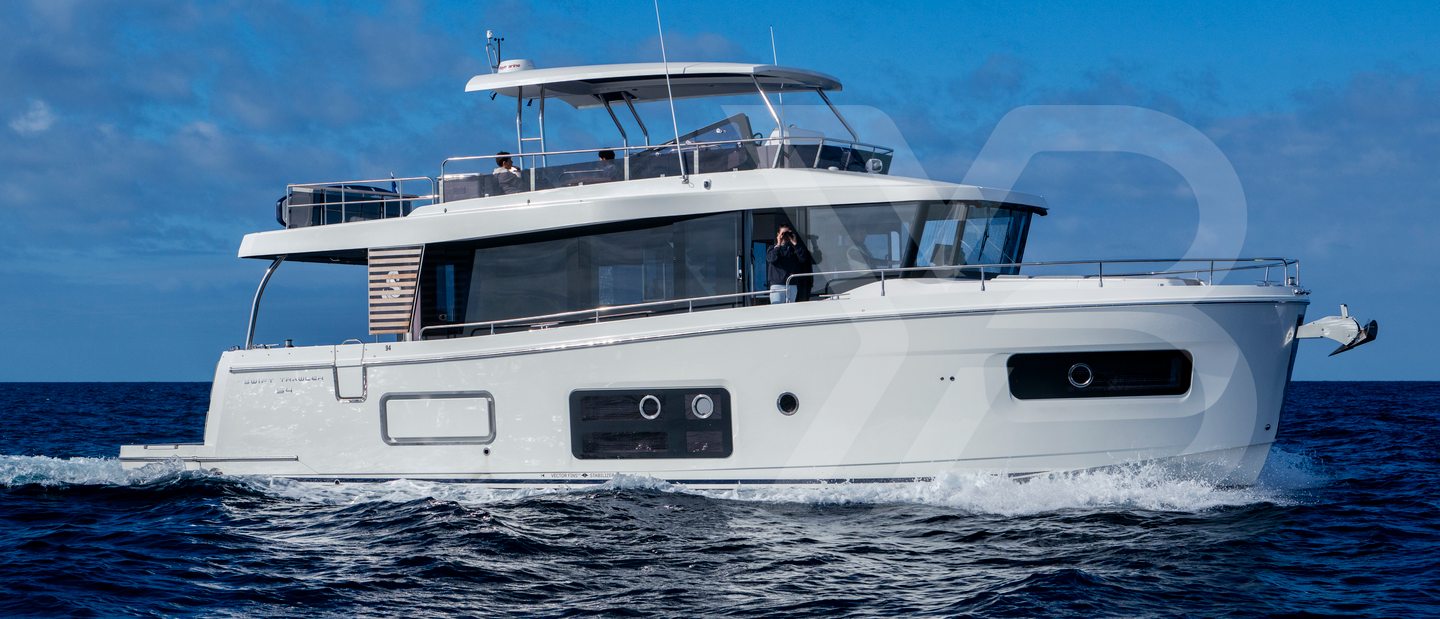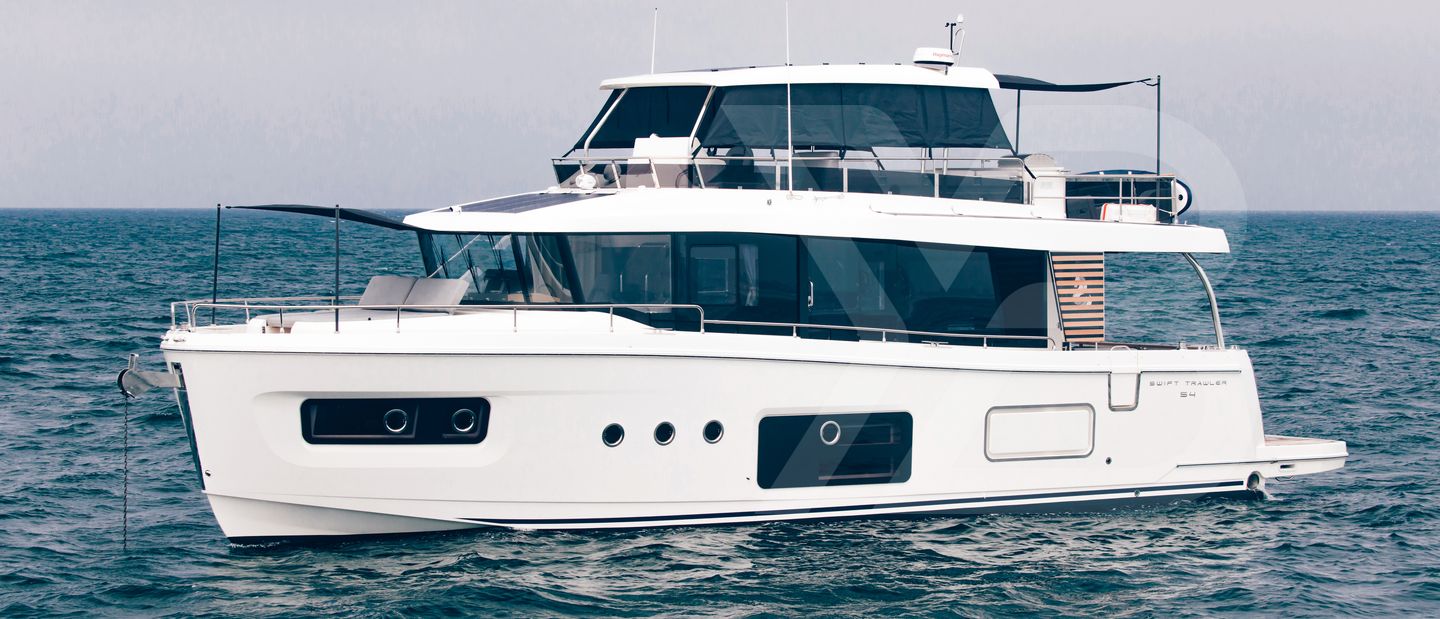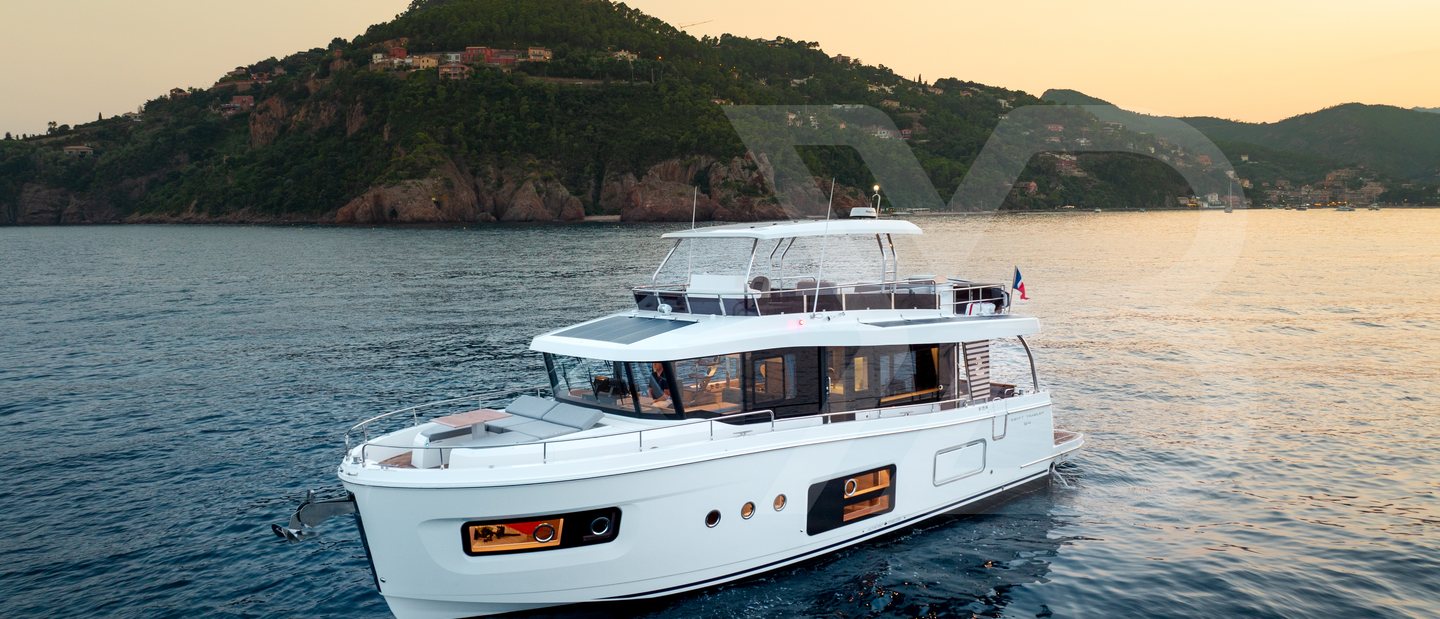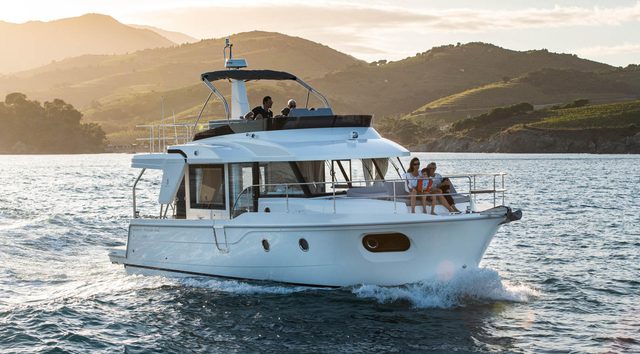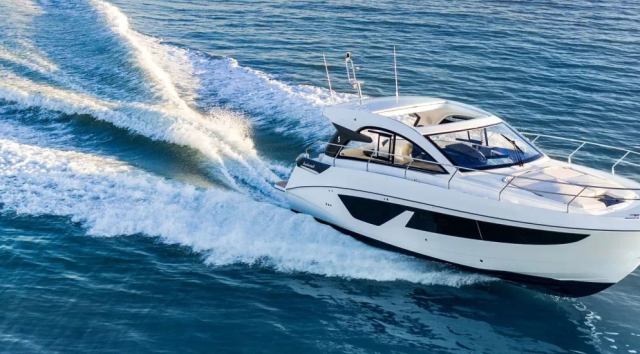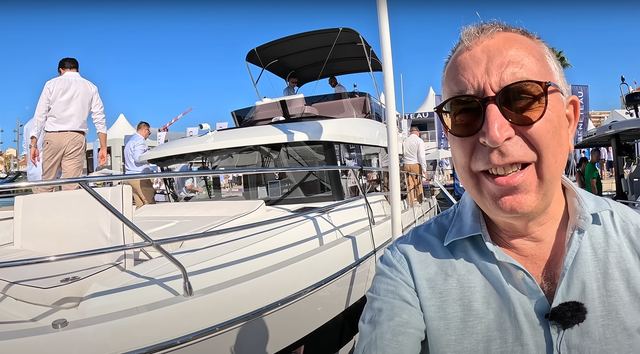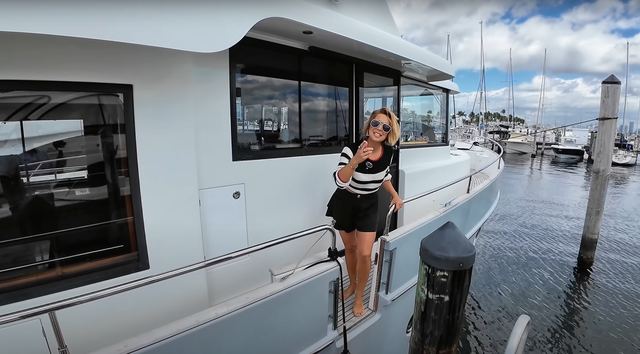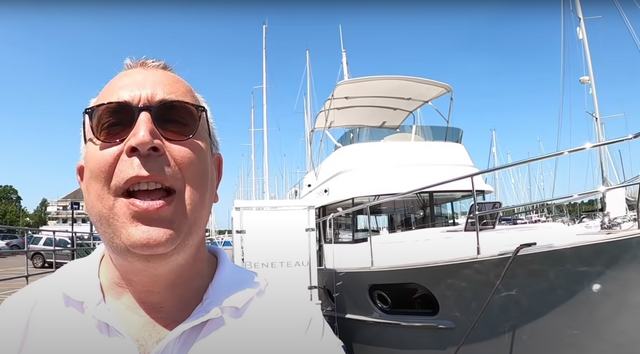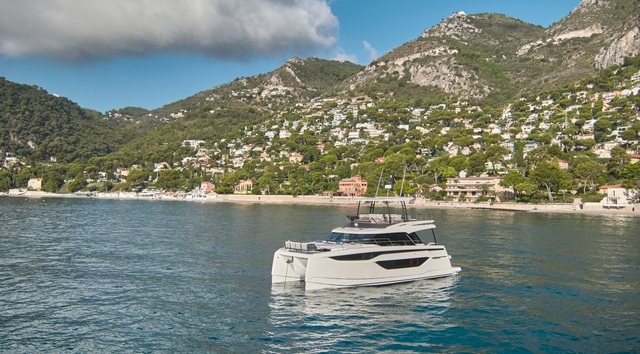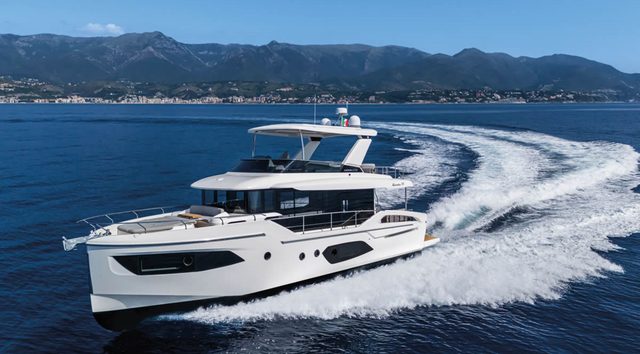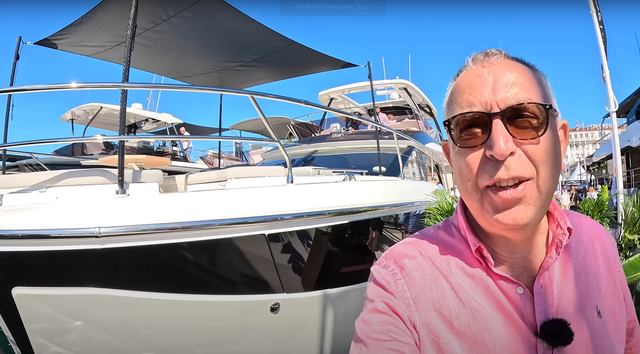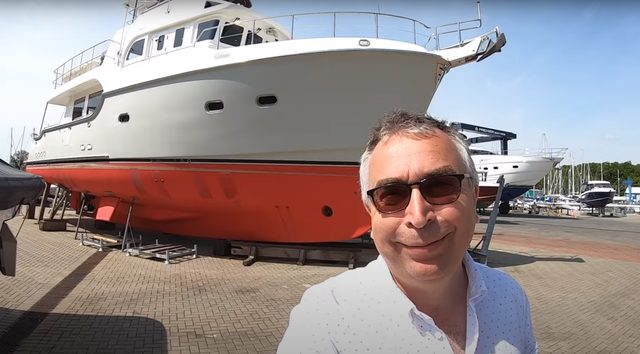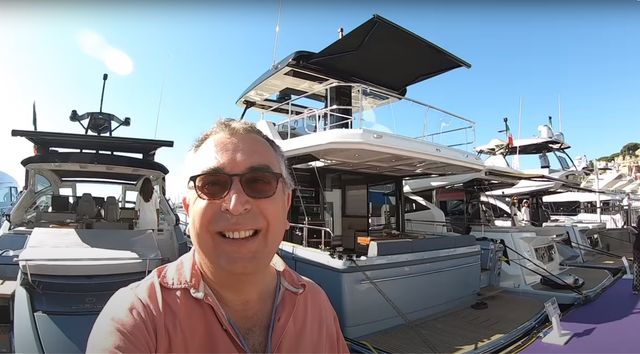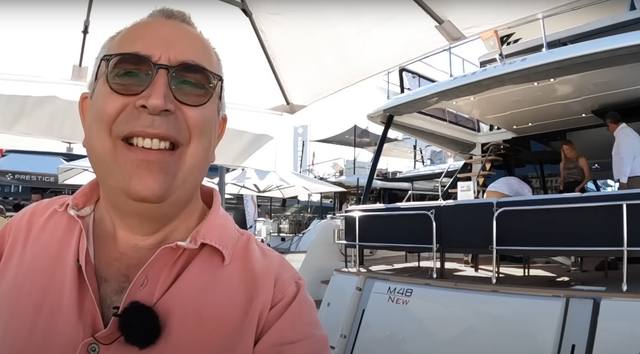The Beneteau Swift Trawler 54, the largest in the range, is built with long-distance liveaboard cruising at its core.
With three cabins for six guests – including a full-beam owner’s suite amidships, a VIP forward, and a third cabin with bunks - plus the option of a compact crew cabin in the lazarette, it’s designed for extended time on board. Let's find out how it does on space, practicality and performance for serious passagemaking, so read on to see how it measures up.
Test & Review Video
Around the Marina
The berth for the day was tight, with smaller boats on either side and a touch of cross tide on the ebb. Low tide gave some shelter from the harbour walls, but the size and height of the Swift Trawler 54 are still felt when threading into a space like this.
This boat was without the optional joystick, a £40,000 system that combines the shafts with the bow and stern thrusters for point-and-shoot control. The standard arrangement of separate throttles and proportional thrusters offers very precise handling, allowing small, measured inputs, although the joystick removes much of the calculation for those who prefer it.
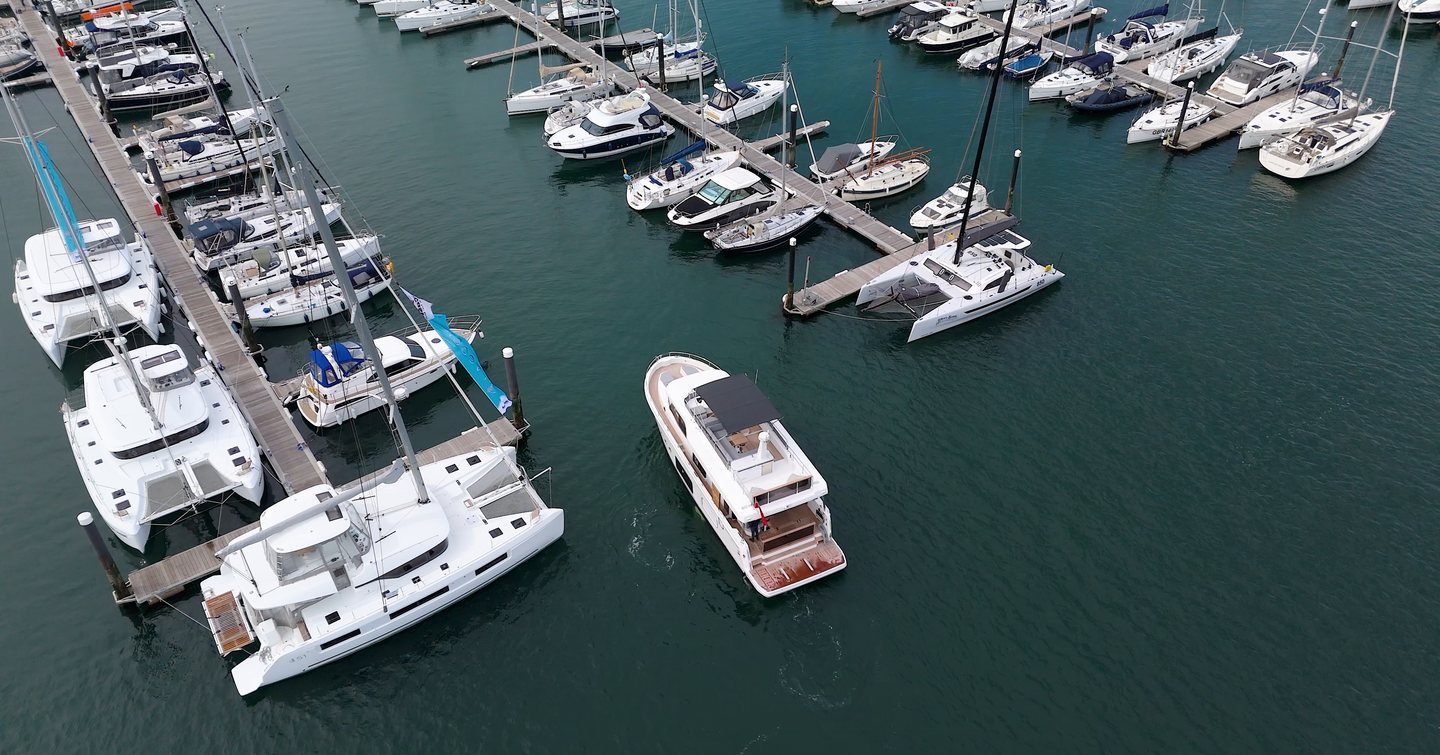
The lower helm is the more practical position for close-quarters work. Doors to both decks make it quick to step out for lines or fenders, and it keeps the helmsman in clear communication with the crew. The aft camera gives an accurate view of the bathing platform’s proximity to the pontoon – a useful feature as the transom is not visible from the flybridge in a berth of this layout. For owners frequently berthing stern-to, the third docking station in the cockpit is a worthwhile option.
Controls are positive, with clear notches when gears engage, and the proportional thrusters deliver exactly as much power as is needed without jolts. High freeboard means the starboard side door sits too far above pontoon height for boarding, so all side gates are positioned aft in the cockpit.
In these settled conditions, the 54 responds quite predictably to gentle inputs, making it possible to work into a berth slowly and deliberately, keeping the manoeuvre controlled from start to finish.



At Sea
The semi-displacement hull means there’s no big hump to get over. Push the throttles, and the bow lifts slightly before the boat digs in and gathers pace. Flat out, it will see around 18-19 knots, though it feels more comfortable sitting at 14-15 knots. At that speed, the engines aren’t working hard, the noise is manageable, and the fuel burn is sensible.
At 15 knots, the pair of 6.7-litre Cummins 550s are using about 130lph in total. Drop back to 8-10 knots, and that falls to roughly 42lph, with a big drop in noise and vibration. With nearly 3,500 litres of fuel on board, that’s good for close to 1,000nm at the lower speed, so there’s no rush if the conditions are right.

The hull tracks straight without much input on the wheel and turns with a steady, predictable feel. Steering is on the heavier side, and this isn’t a boat for throwing around - it’s happier finding a groove and covering the miles. This one has Sleipner Vector fins fitted; they weren’t needed on the calm day of the trial, but at rest or in a beam sea, they’ll take the roll out. The boat also runs with a nice, level attitude without using the trim tabs (traditional Lenco flaps), so they were left alone all day.
From the lower helm, the engines make themselves heard at higher revs, enough that voices need to be raised in conversation. On the flybridge, it’s quieter with more airflow and a wide view ahead, but despite being higher up, the quarters stay hidden without help from the crew or cameras. In heavy weather, the autopilot would likely be doing most of the work, holding course while the hull shoulders through. Smaller Swift Trawlers have felt very capable in big seas, and there’s no reason to think this largest model wouldn’t behave the same way.
It’s not an especially exciting boat to drive, but it is composed, predictable and sure-footed - exactly what you want from a long-range cruising hull.
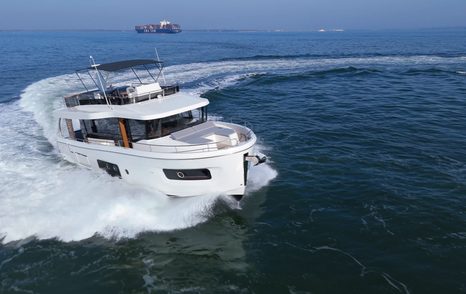


Two decades after the ST42, the Swift Trawler 54 arrives as the biggest Swift Trawler to date, with naval architecture by Bill Dixon with styling from Andreani. It sits between the 48 and the Grand Trawler 62, aiming to give you the long-range capability and systems depth of the flagship without the jump in size and cost.
The hull and deck of the ST54 are an infused GRP sandwich with a balsa core for stiffness and weight control, bonded to a monolithic structural liner, with Dixon’s Fusion hull form setting the geometry. Sound insulation in the machinery space is generous, and the deck spec includes Irodeck on the bathing platform, cockpit and aft side decks, with the option to continue it forward and onto the flybridge.
It feels solid and ready for serious use, but the finish is more about being practical and easy to live with than chasing the glossy look you see on an Absolute, Azimut or Princess. That is in line with the price and with the whole idea of keeping things straightforward to maintain.
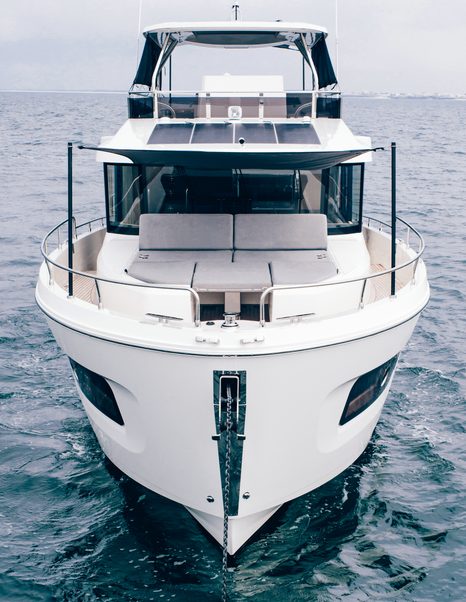

The electrical backbone is scaled for real cruising rather than day boating. Seanapps connected monitoring and Ship Control bring checks and controls into one place, while dedicated battery banks serve services, engines and thrusters. Twin 24v chargers, a full LED lighting scheme and a choice of generators from 6.5 to 15.5kW are paired with a 2kW inverter in the comfort packs, so running the boat away from shore power is straightforward.
Owners who want quiet at anchor can go for the Silent Boat Pack. That swaps the bimini for a T-top and adds 18 solar panels and ten 24v lithium batteries, which together deliver roughly a full night of no generator time. Sleipner electric Vector fins are on the options list for roll reduction underway and at anchor, and the Cummins joystick package blends the shafts with progressive bow and stern thrusters, with the option of a third docking station in the cockpit.
The usability reads true to the Swift Trawler brief. You get deep bulwarks and twin side doors for safe circulation, sensible technical access throughout, and a flexible space under the cockpit that can stay as a big lazarette or be fitted as a compact crew or utility area. Beneteau leaned on owner feedback for the storage, the easy-load lazarette and the workshop-friendly touches, so day-to-day living and maintenance feel thought through.
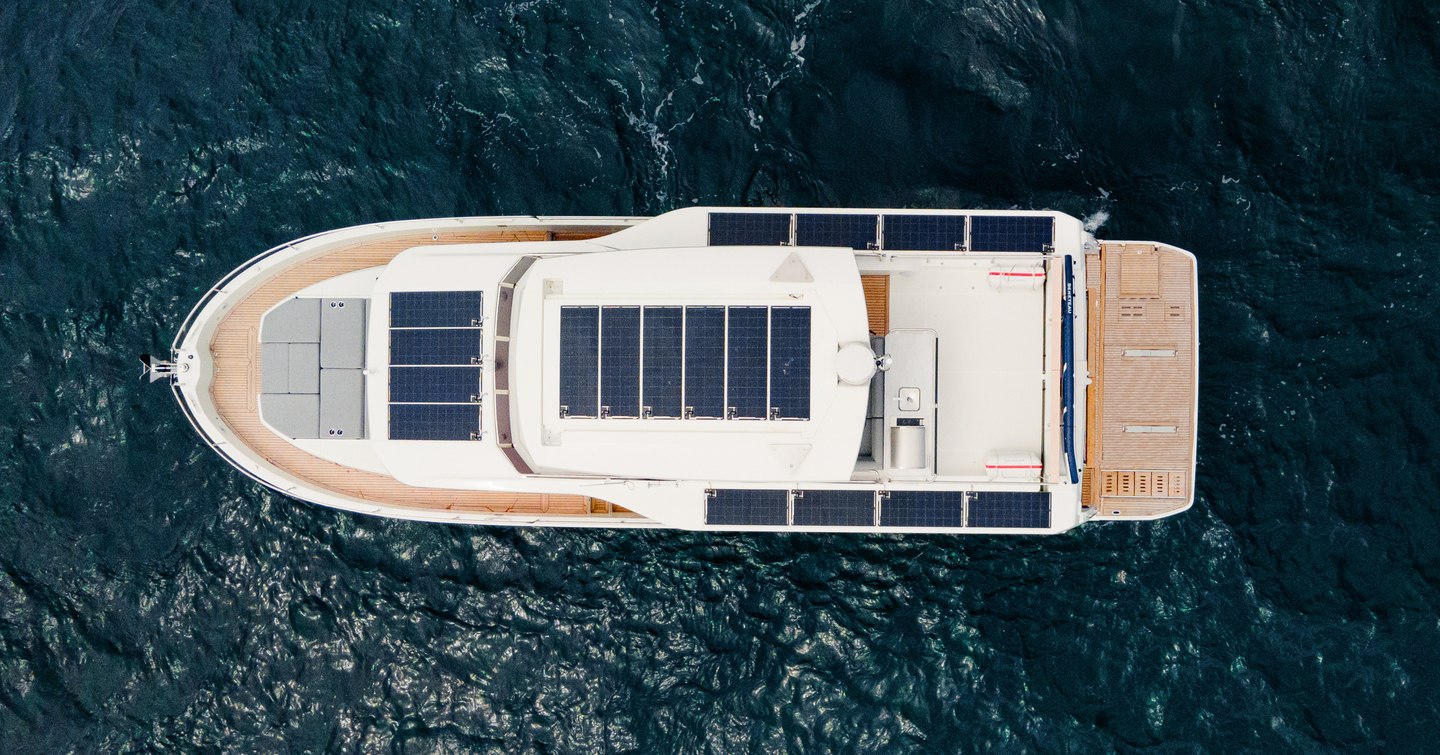
Engine Room
You can get to the engine room a couple of ways: through the lazarette via a watertight door, or from a hatch in the cockpit that brings you down into the little ante-room between the lazarette and the engines. That main aft hatch is gas-assisted, so you’re not having to heave up a heavy panel, and it means you can get in here without shifting anything in the cockpit.
Headroom is pretty restricted once you’re inside, but the engines are so diddy for a boat of this size, it’s remarkable how much space you get around them. These are the 6.7-litre Cummins diesels, 550hp each, straight shaft, and it's the only engine option. Super reliable and the smaller footprint just makes servicing, checking and moving around that much easier.
You’ve got chequer plate underfoot, which is nice and secure even if it’s hard on the knees, and nearly 3,500 litres of fuel split between the tanks aft of the engines. Grab rails through the middle give you something to hold if the boat’s rolling, and things like oil checks, raw water strainers and fuel filters are all right where you want them.

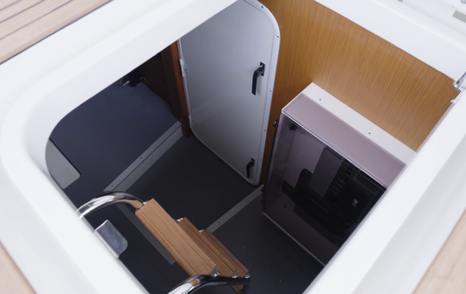
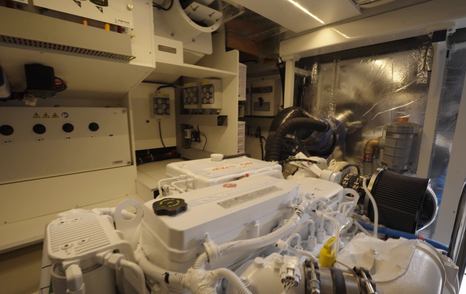
Inside, the layout feels built for life underway. The lower helm is front and centre, with the raised dinette opposite, so whoever is off watch can still be part of the passage. That table is fixed here, but it can be ordered as an up-down version that drops to create a watch berth, giving a place to rest without being far from the action. Large forward windows give everyone at this end of the saloon a clear view ahead, so even on a long leg it feels connected to what is happening on deck.
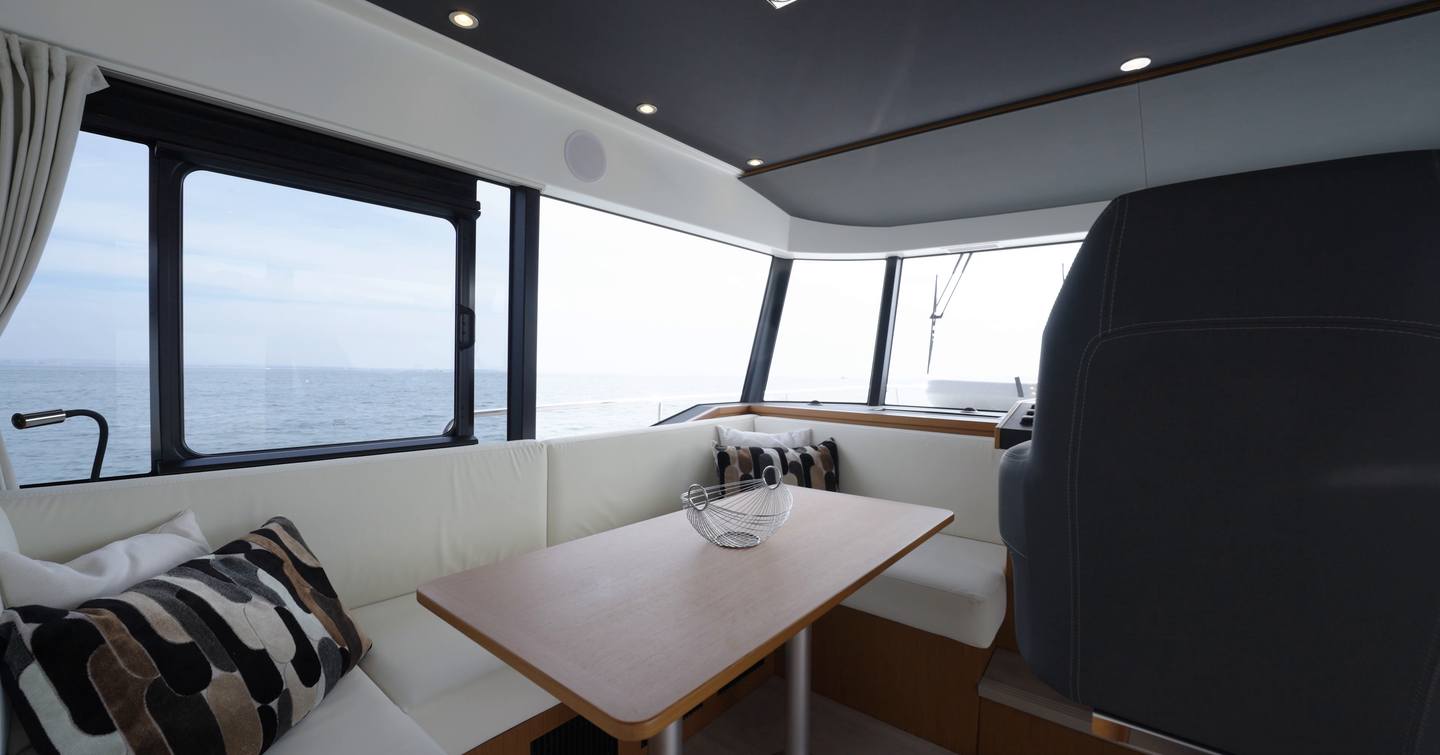
The galley is positioned amidships, arranged on either side of a side door, within easy reach of the helm and the dinette. Split across both sides, it has plenty of counter space and a full domestic fridge and freezer. This boat has a gas hob and oven, but induction is also an option.
Overhead lockers, deep drawers and tucked-away bins show how much thought has gone into storage, and the layout means you can grab a drink or prepare a snack without being cut off from the rest of the crew.
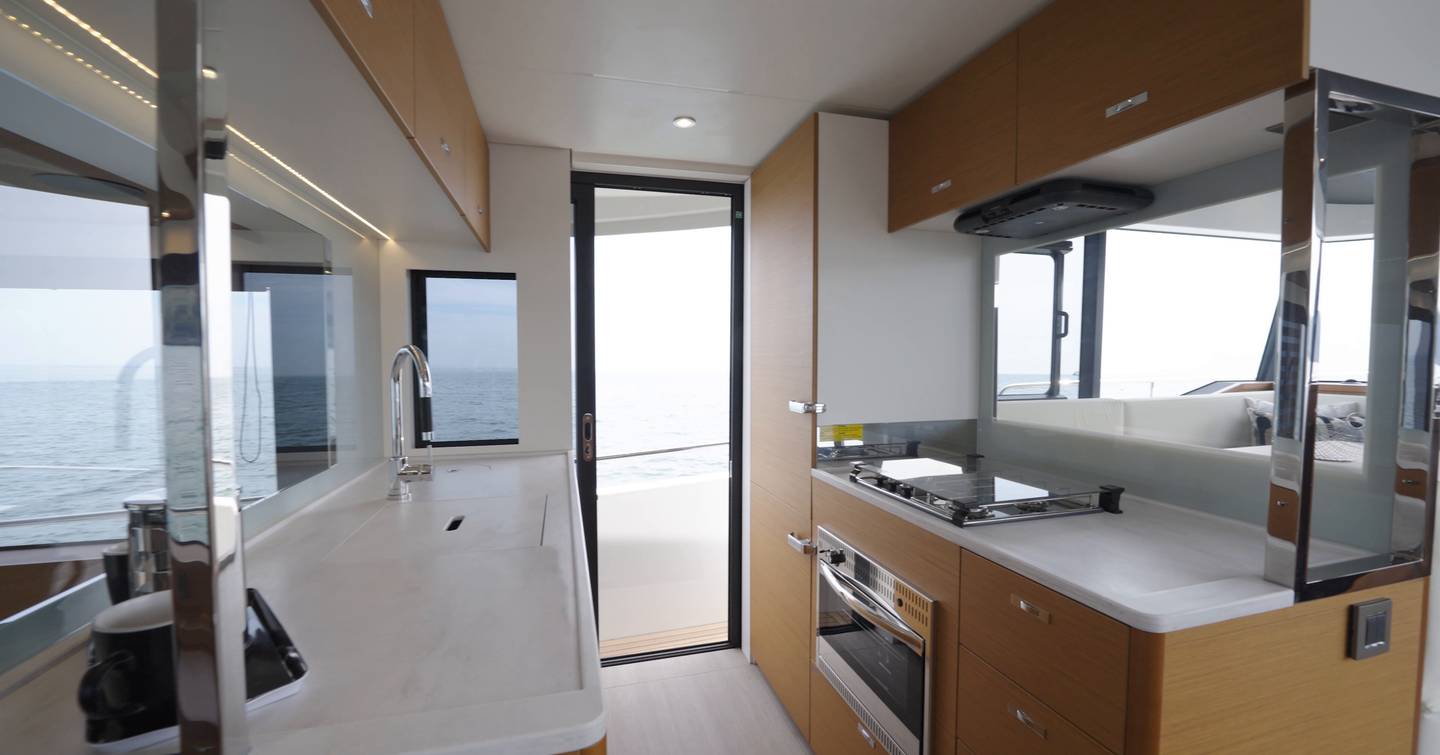
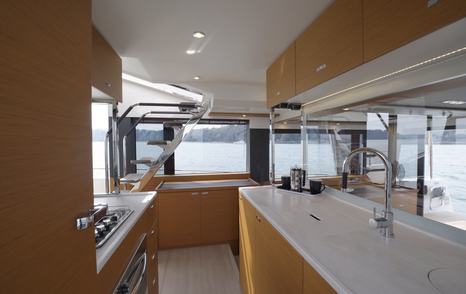

Aft, the lounging area is set up for downtime once the engines are quiet. Big picture windows bring in plenty of light, and the 50-inch TV hides away when not in use to keep the view clear. Loose items stay put thanks to the low fiddles built into the cabinetry, and deep lockers hide technical gear such as the fuel shut-offs alongside everyday essentials. The connection to the cockpit works both ways - open the doors and the two spaces join together for sociable evenings in port, close them and the saloon becomes a warm, comfortable refuge on a passage.
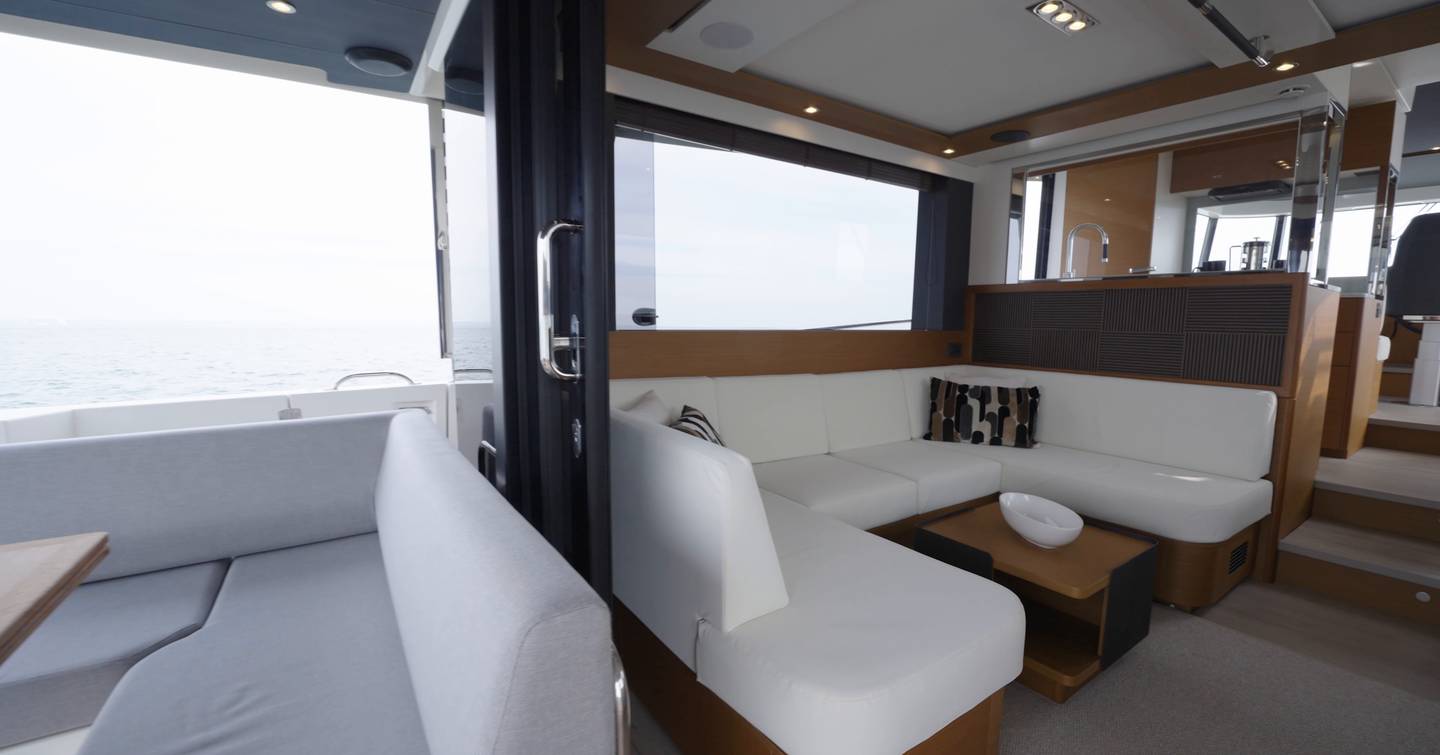
The lobby at the foot of the companionway has been put to use with a couple of practical touches. On one side there’s a tall locker sized to take the folding director’s chairs for the cockpit, or it can be used as hanging space for wet weather gear. On the other side, a panel gives access to fuses and electrical systems.
A washer-dryer is fitted here between the cabins, with open shelving above for laundry supplies or general stowage. Having it in the middle of the accommodation makes it easy for everyone on board to use without taking over space in a cabin.

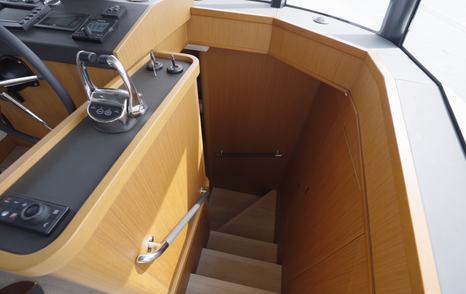
Owner's Cabin
The full-beam owner’s cabin is set amidships in the widest part of the hull, so it makes good use of the space. There are some level changes in the sole to follow the hull shape, though headroom is still fine for moving around the bed. The berth is a practical size, with drawers underneath and an ottoman lift for bulkier items. Hanging lockers on both sides take care of clothes, and the large hull windows have opening portholes for ventilation.
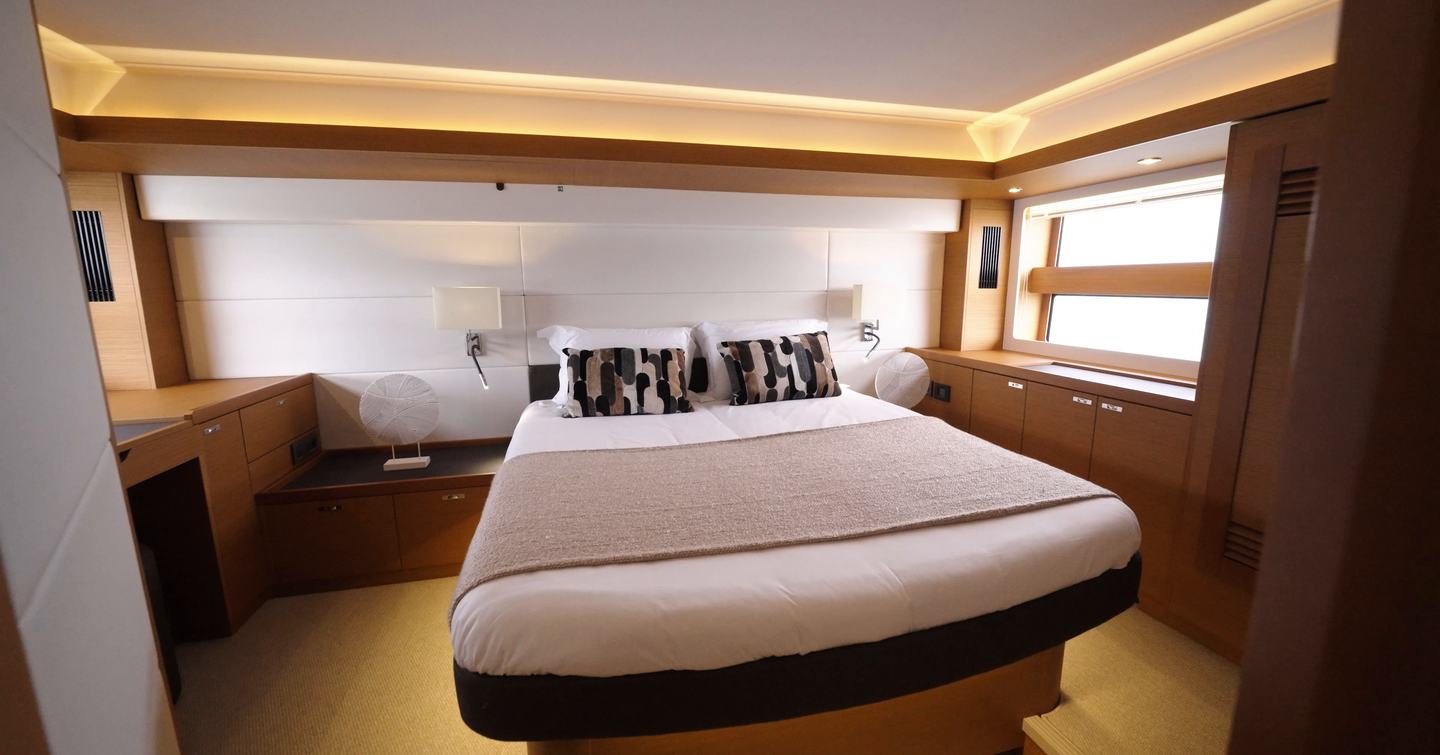
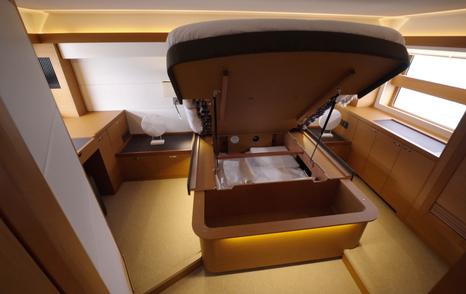
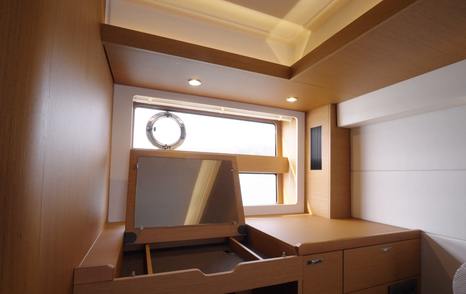
On the starboard side, there’s a bureau that doubles as a vanity. This boat is finished in the darker wood option, and there’s also a lighter oak if you prefer a brighter look. Climate control is fitted and keeps the space comfortable in warm conditions.
The ensuite has a separate shower cubicle with a rain shower head and a Corian counter around the basin. The two doors do tend to get in each other’s way when they’re open and neither pins in place.
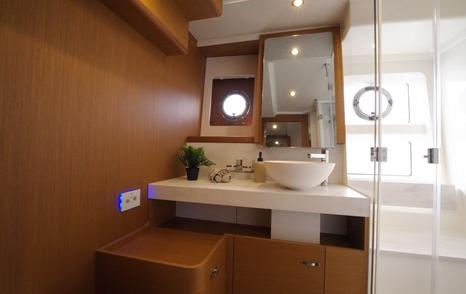
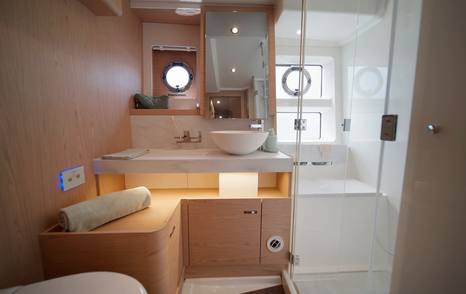
VIP Cabin
The VIP sits forward with the berth set low enough to make it easy to get in and out from both sides. Storage is good, with a full-height hanging locker to starboard, overhead lockers and more space under the bed. The hull windows are almost as large as those amidships, and there are opening portholes for ventilation.
A small bureau is tucked in behind the door, useful as a dressing table or a place to keep personal bits and pieces. Fiddled shelves at the bedside stop things sliding when the boat moves, and there are sockets close to hand for charging devices.
This cabin shares its ensuite with the third cabin, and it also acts as the day head. There is a separate shower cubicle, although the head itself is positioned behind the door, so it is a little awkward to get to.
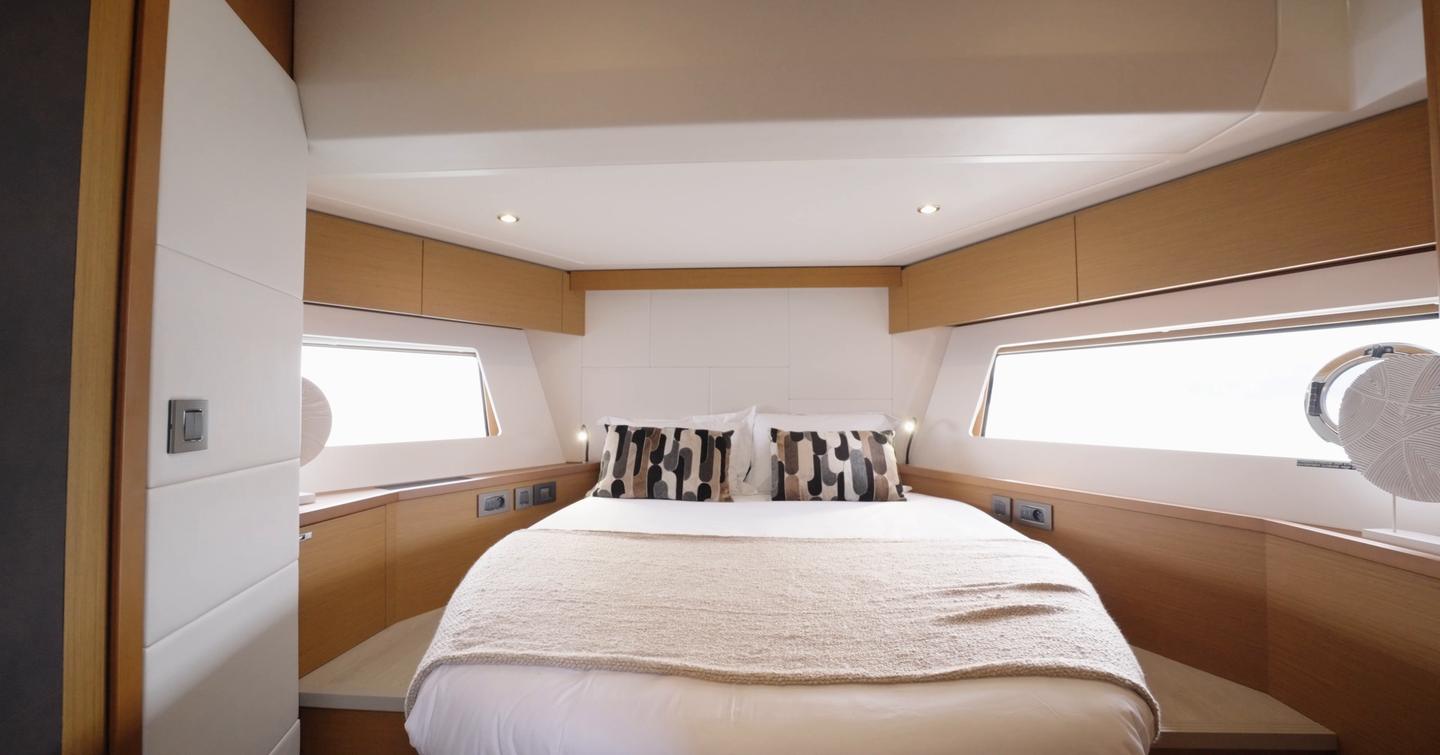
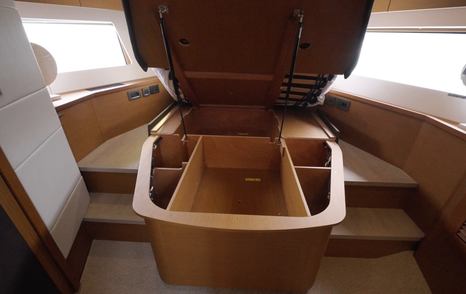
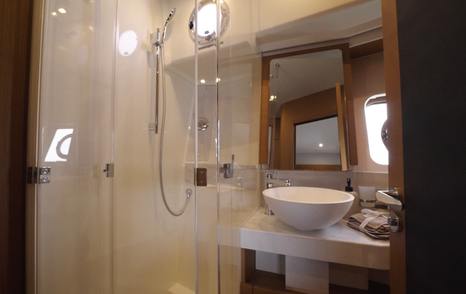
Third Cabin
The third cabin is set up with over-under bunks, which makes it a good space for children or occasional guests. There is storage under the lower berth and more built into the aft bulkhead, making use of otherwise wasted space.
This cabin has direct access to the day head, so it works as an ensuite in this layout. If you choose to have a double berth instead, that access is lost.
It is a compact space, but the layout and storage solutions make it functional for its size.

There’s no gimmicks at the flybridge helm with all the major controls where you want them. The single helm seat has good side support, and alongside it there’s a companion area that flips into a chaise longue with an infill cushion, so someone can stretch out and still have a great view forward. There’s enough space to move past without disturbing the helm, which makes a difference on a longer run.
The wheel is fixed but within easy reach, and the throttles sit close enough that you can stay seated and still work them comfortably. This boat has two 12-inch displays, which is fine as you can split them to show four different functions at once - though you can go up to three 16-inch screens if you want the extra real estate. Cameras for the aft deck or engine room can be linked in too. If you stick with two screens, the space for the third becomes a useful deep locker with a charging point, perfect for tablets and phones.
Seated low you can’t quite see the bow rails, so in lumpier water the bolster will give you that extra bit of visibility. The internal stair down to the saloon makes swapping between this and the lower helm quick and easy, so you can choose whichever driving position suits the conditions.
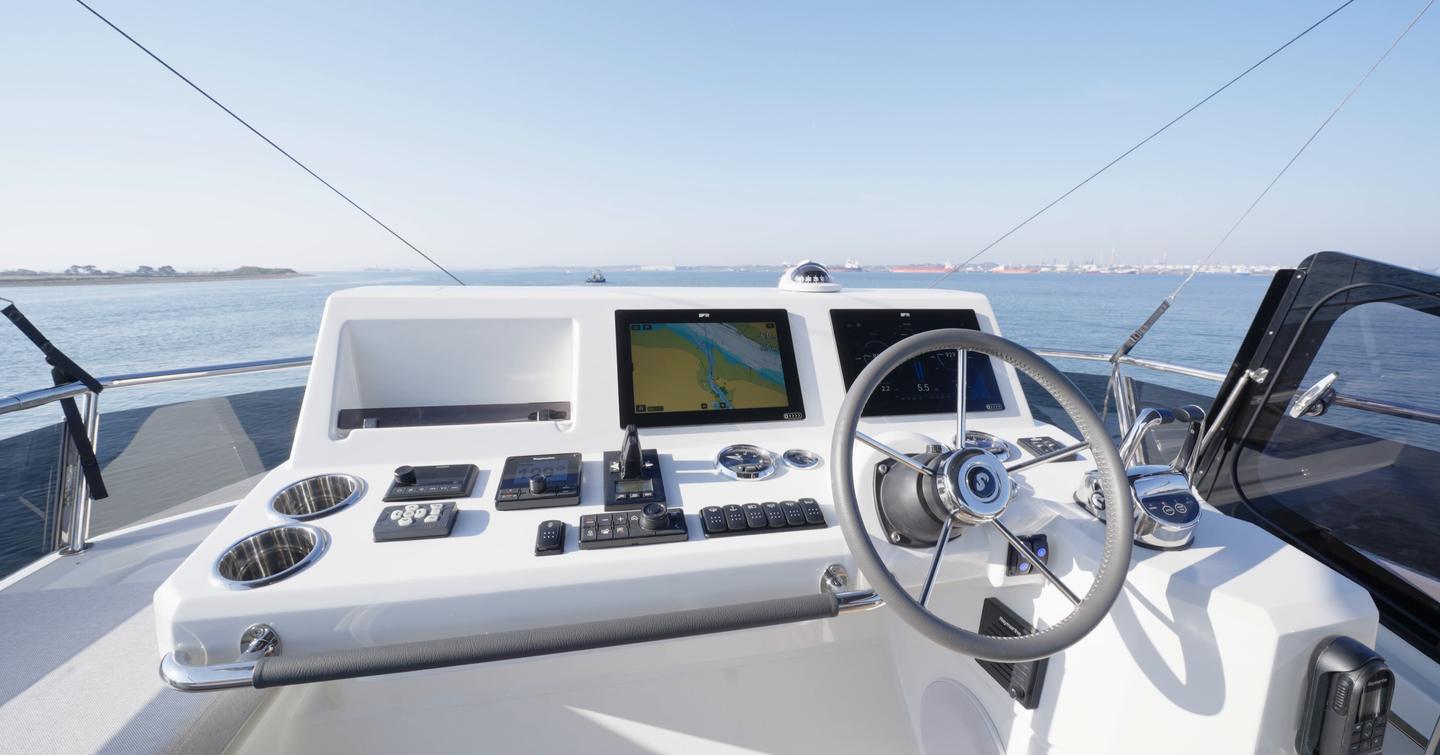

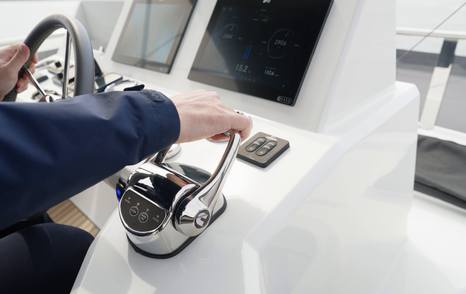
Lower Helm
Down at the lower helm, you sit right on the centreline, a long way forward and with a fantastic view ahead. The inwardly raked windscreen has slim mullions, so forward sightlines are excellent, although the uprights to either side of the galley do create blind spots to the quarters.
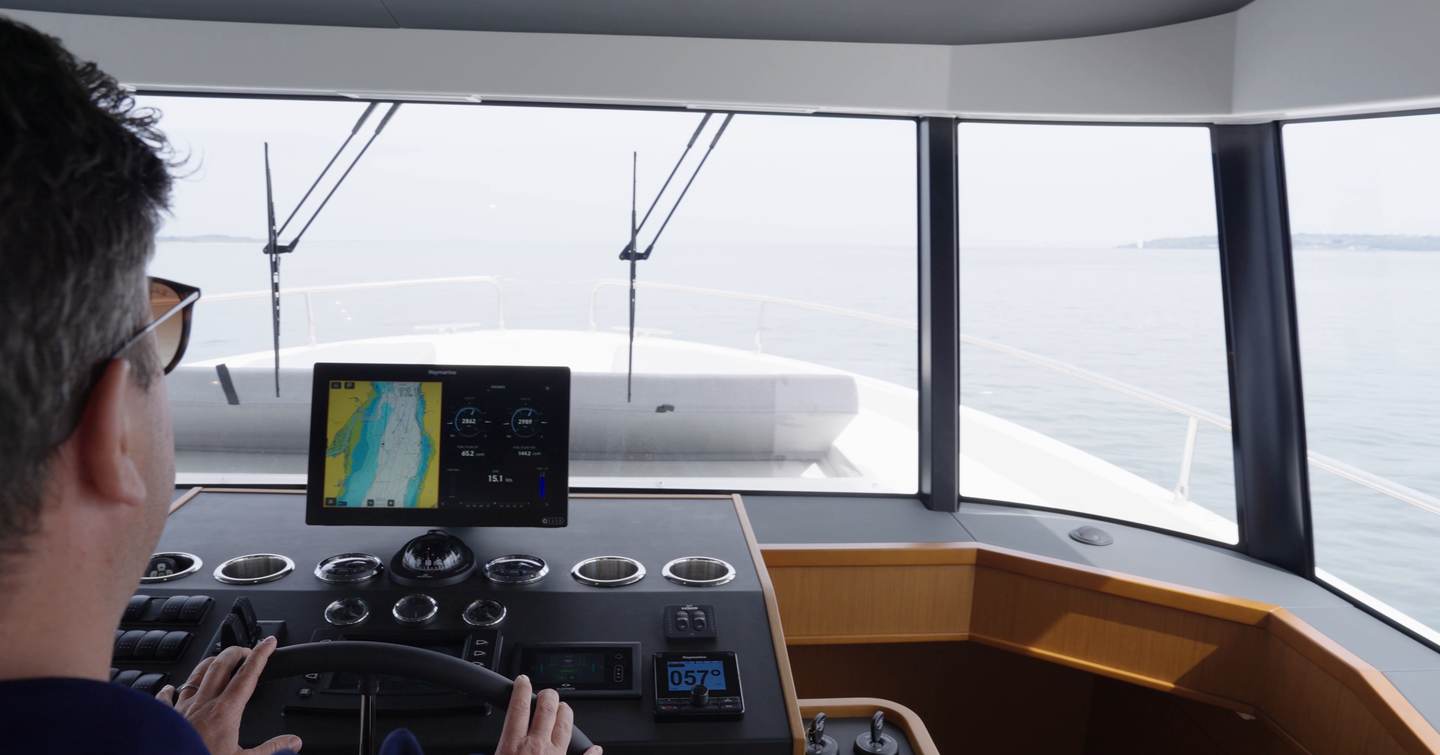
The helm seat here is a proper chair on an electric pedestal, so you can raise or lower it to suit. The wheel is bigger than upstairs, and that extra leverage makes the steering a touch lighter. Throttles could sit a little further back to be perfect, but they’re close enough that you can drive in comfort for hours.
You can fit two 16-inch displays here, which is worth doing for the extra screen space when the weather closes in, so the radar, charts, cameras, and engine data are all on show. There’s also a second Cummins display for the engines, and all the major controls are grouped where you can reach without leaning. The dash is finished in black to cut glare, with chunky, tactile switches rather than a uniform glass panel.
From here, you’re well connected to the dinette and galley, so whoever’s on watch is part of the conversation and close to the snacks.
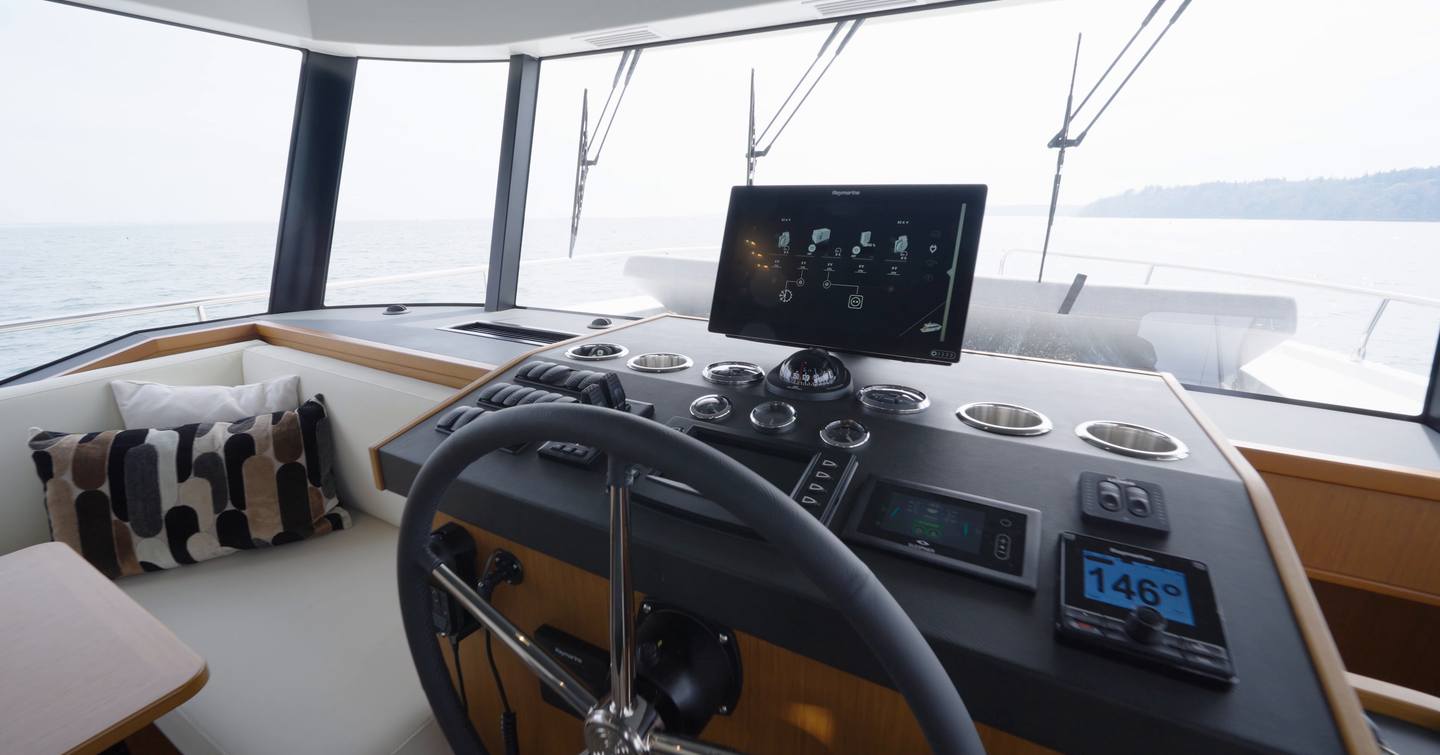
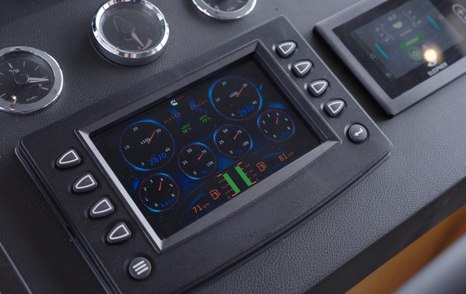
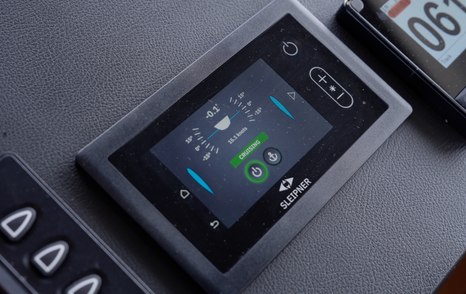
Life at anchor is made easier by the way the stern is set up. The hydraulic platform turns into a private water terrace, dropping smoothly into the sea with a set of built-in steps. Your tender sits on its chocks, rated to 400kg, so it is always ready to launch for a run ashore or an afternoon exploring. A folding swim ladder deploys in seconds when you want a dip and tucks away again to keep the deck clear.
After a swim, the hot and cold deck shower is right where it's needed, so you can rinse off before heading inside. Just forward, a wide gas-assisted hatch opens to the lazarette. This is prime storage for bulky kit, paddleboards, diving gear or anything else you do not want cluttering the decks. If your plans call for extra hands, the space can be fitted out as a compact crew cabin with its own toilet and sink. From here, a watertight door leads directly into the engine room, so checks and maintenance can be done without disturbing anyone in the cockpit.
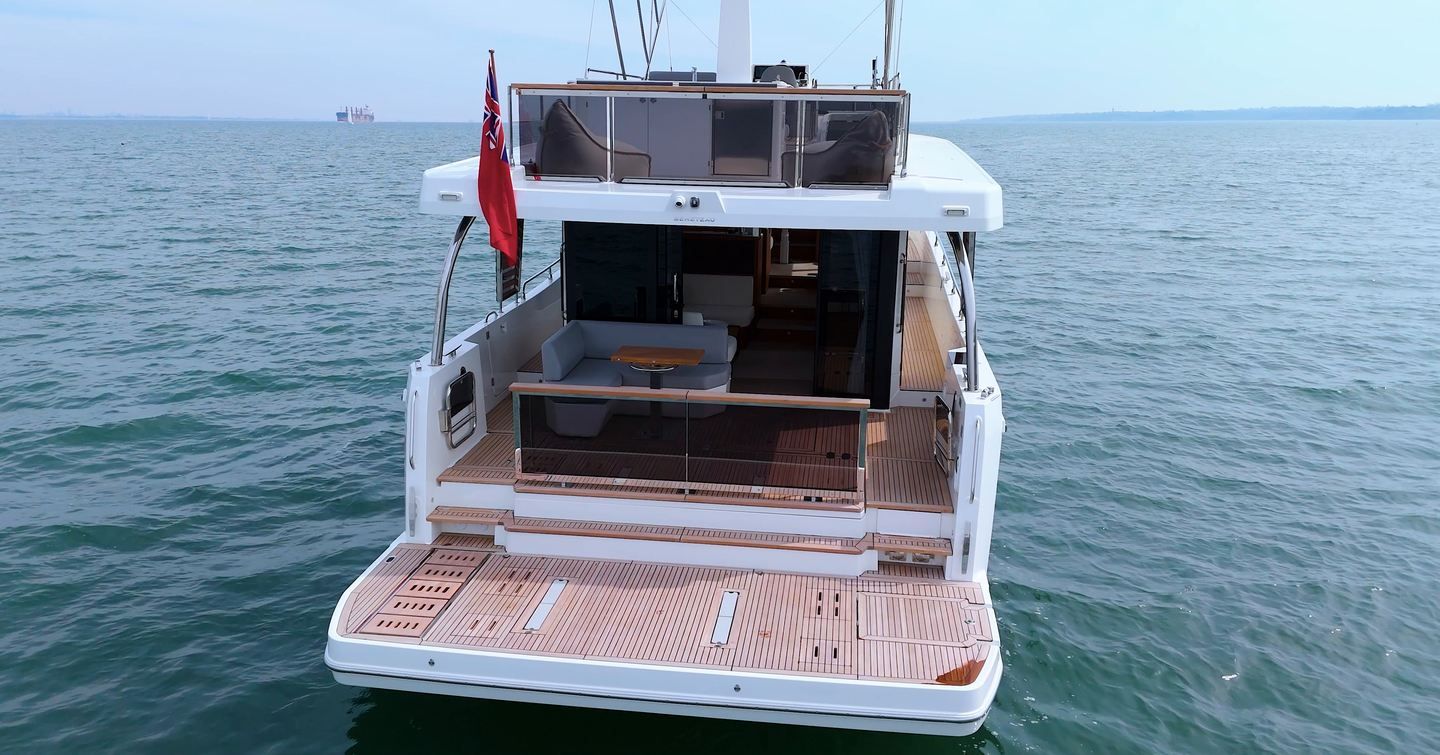

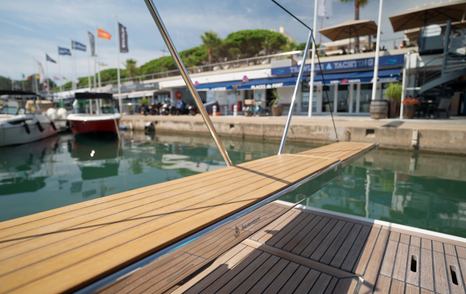
The cockpit itself feels like a natural extension of the saloon, sheltered by the flybridge overhang and protected from the breeze. Because the hatch to the lazarette needs room to lift, the fixed seating runs along the aft edge, leaving space to bring out a couple of director’s chairs from storage if you want to seat more people.
The table folds out to make a decent dining spot and, thanks to the clear transom panel, you can still enjoy the view aft while sitting down. It's fair to say, though, there are rivals to the ST54 that have cockpits better suited to dining with more substantial seating blocks.
On the starboard side, there is a neat cassette passerelle hidden underfoot, deployed when you are moored stern-to. Just ahead are the controls for the hydraulic bathing platform, and if you go for the optional third docking station, this is where the joystick would live. You can also spec winches on both quarters to make tightening stern lines easier.
It is a pleasant place to sit even when you are underway, protected from the breeze by the wheelhouse and close enough to watch the wake spilling out behind. The whole area can be enclosed with covers for extra shelter at anchor or in port, and overhead handholds give you something to grab if the boat moves while you are crossing the deck. It is a straightforward, practical cockpit that still manages to feel inviting.
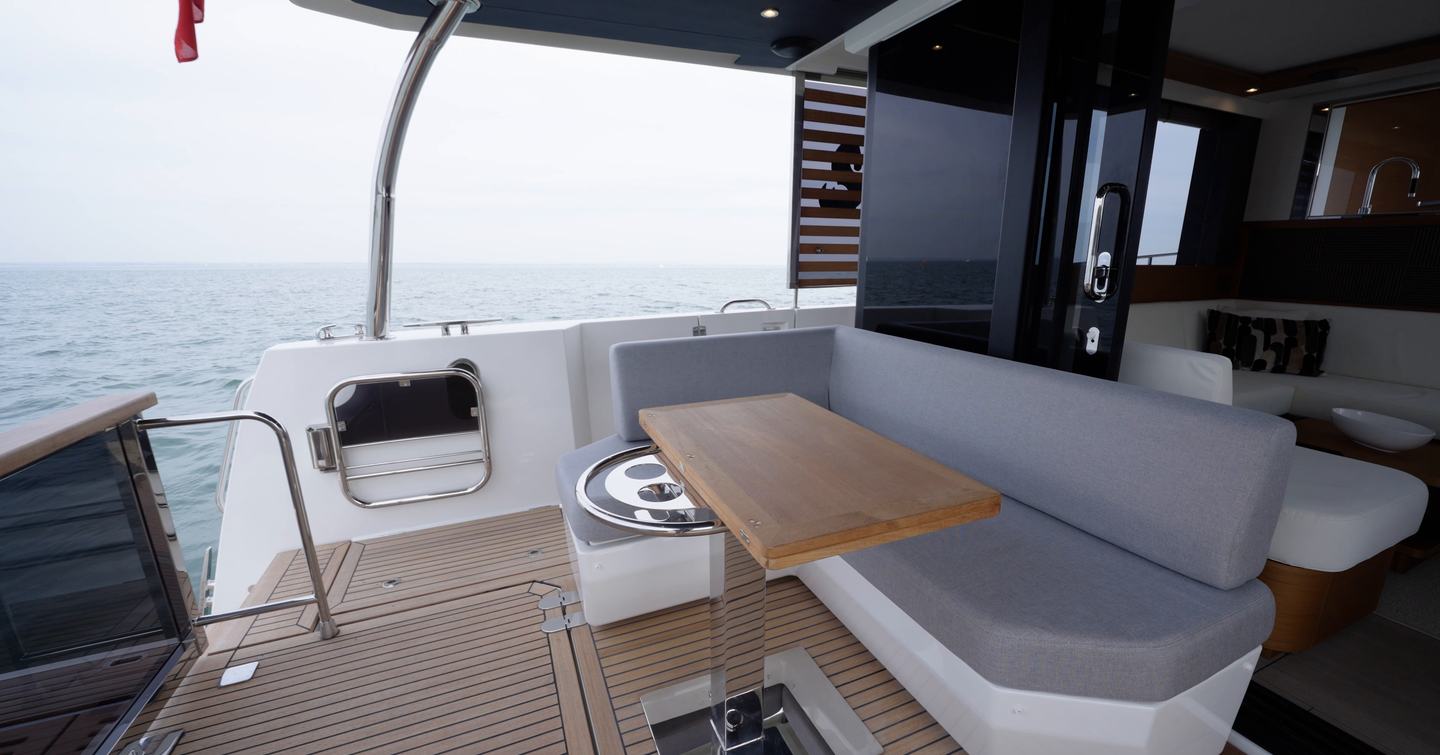
Side Decks & Foredeck
Gates on both sides of the cockpit swing open for stepping ashore when you are alongside, and the decks stay level as you head forward. There is good overhead protection along much of the walkways – a classic trawler trait that keeps you dry and steady in a swell, and tall bulwarks with chunky rails give a secure feel. Doors on both side decks can be closed to block the wind when it is coming over the bow, making the cockpit even more comfortable at anchor.
Fuel and water fillers are tucked neatly into the side decks with small lips around them to catch any spills before they hit the deck. It is the sort of tidy, practical thinking that runs through the whole boat. Moving forward, the symmetry of the decks makes it easy to work lines or handle fenders from either side, and the low-set profile compared to a traditional flybridge gives the feeling of being closer to the water while still well protected.

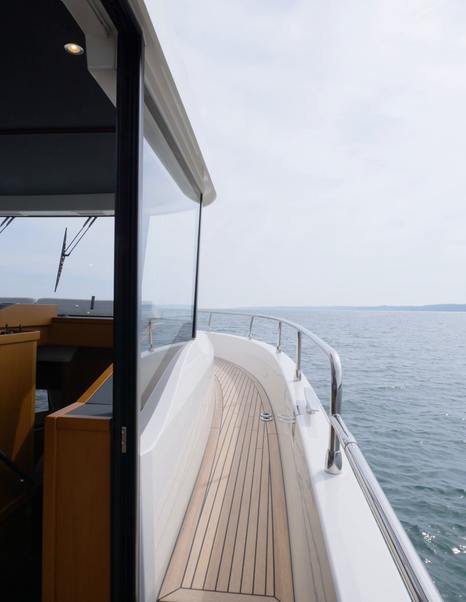
As standard, the foredeck is a straightforward lounging space, but this is one area where a few upgrades earn their keep. The wide sunpad has pop-up backrests and cup holders built in, plus storage underneath, but adding the optional table in the middle transforms it into another dining spot. That same table drops down to join the cushions, giving you a sunbathing area big enough to share.
A canopy is another worthwhile extra if you plan to spend time here at anchor - it turns what could be a short stop in the sun into an afternoon in comfort. Beneath the seating, dedicated fender stowage keeps the deck clear, and the split anchor locker is sensibly laid out so lines and fenders stay on one side and the chain stays on the other. Windlass controls are right where you need them, and there is even a ladder down into the locker for easy access.

Flybridge
Access to the flybridge is by an internal staircase from the saloon, which keeps the decks clear and means you can move between levels without braving the weather. It is the only access point, however, as you do not get a second set of steps from the cockpit. The trade-off is more space both aft on the flybridge and below in the cockpit.
Forward, the helm sits to starboard with a single seat and a companion area to port. That companion space can be turned into a chaise longue with an infill cushion, giving a great forward view whether you are underway or just taking in the anchorage. There is room to move past without disturbing the helm, so it works well for both helming and relaxing.
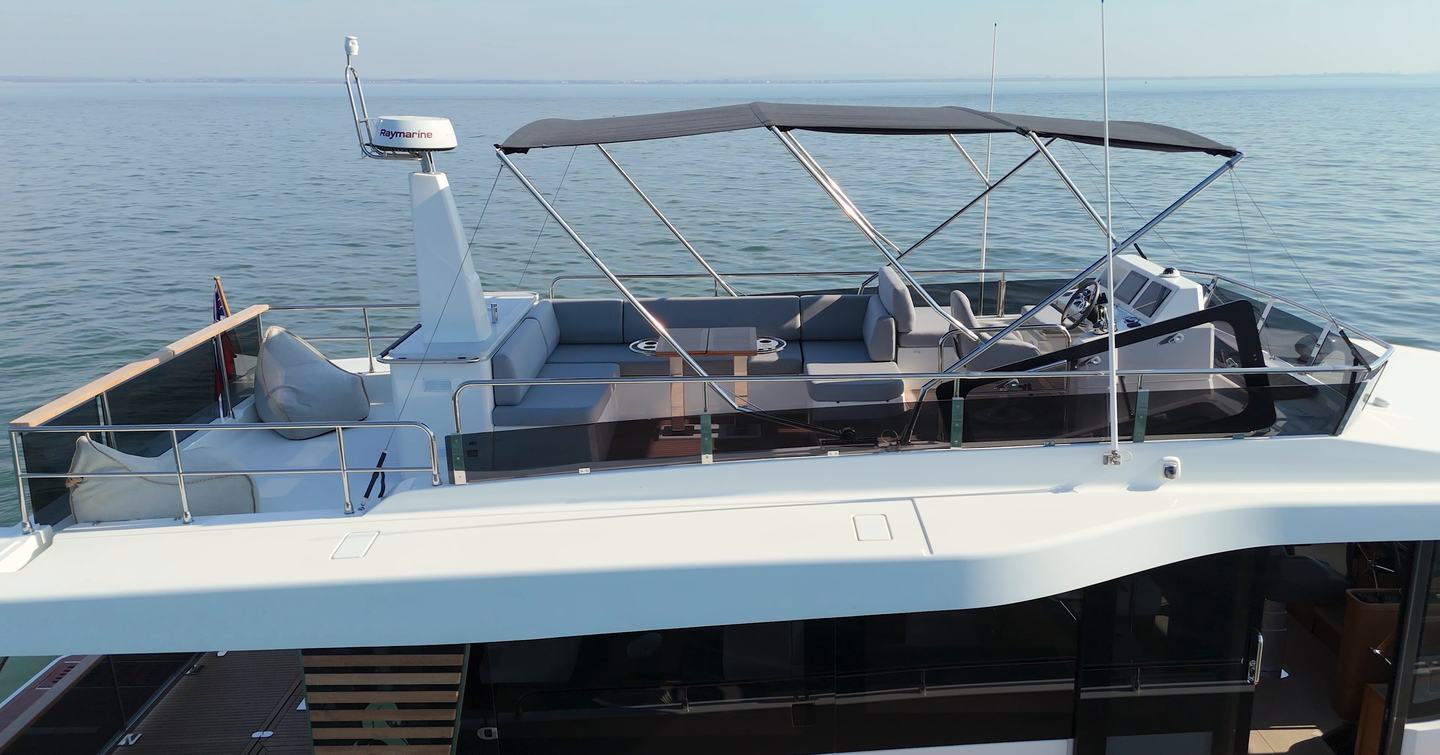
Amidships is the main dining area, with a table that folds out to seat a full crew and space on the inboard side for loose chairs. It is positioned close to the galley below, making it easy to serve meals up here, and it will likely become the main dining spot given the more limited seating in the cockpit.
Cover is by choice - nothing as standard, or you can go for the electric bimini fitted here, which has plenty of headroom and can stay up at speed. A hardtop with a sunroof is also on the options list, and if you opt for the Silent Boat package, that is where the extra solar panels go.
Aft, there is a long bar unit with storage and space for a proper grill, plus a fridge and ice maker if you choose. The deck is finished in Irodeck, except for the working area right aft which is left in moulded GRP to make cleaning up after cooking easier. This open space can also be fitted with racks for paddleboards as part of the same package that adds a crane to the lazarette below.
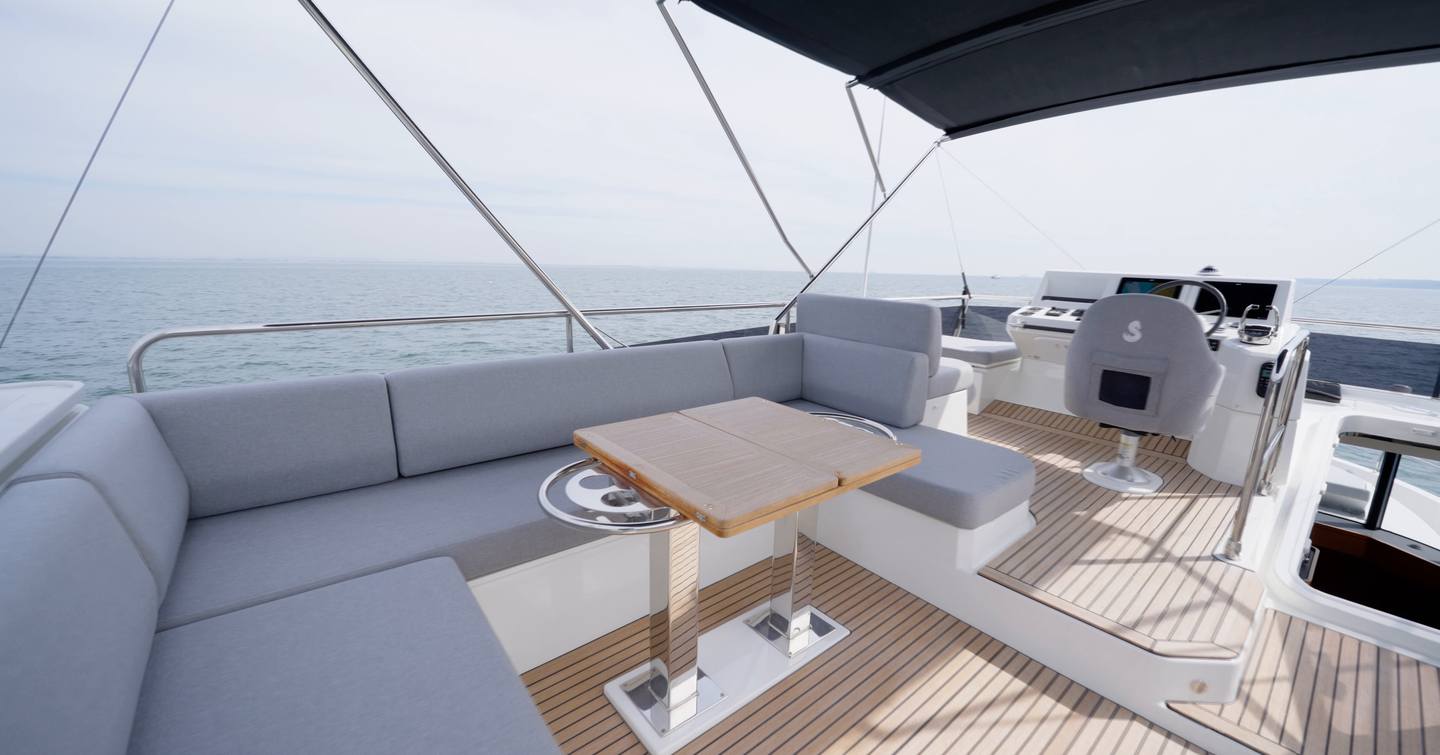

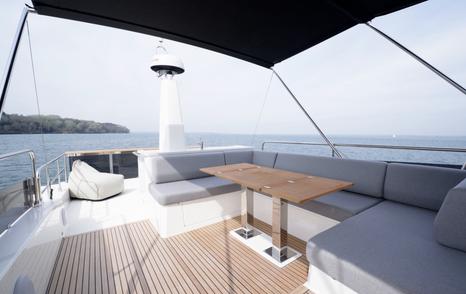
The base price for a Swift Trawler 54 in the UK (at the time of writing) is £996,754 ex VAT with the twin 550hp engines and no joystick. Decent value for the amount of boat you're getting, and even with the customary extras fitted, you'll be looking at around £1,500,000 ex VAT for a well specified example.
Our Options & Pick
Some of the cost options we would consider include:
Lounge trim level (£95,912); upgraded Raymarine electronics (£48,754); Iroko decking throughout (£19,500); lazareete crane and SUP davit (£2,430); passerelle (£38,509); flybridge bimini (£23,684), dual station bow and stern thruster (£20,614); Zipwake trim tabs (£8,947); Sleipner fin stabilisers (£90,737) and 50,000BTU air-con (£41,140).
Our Verdict
The Swift Trawler 54 feels like a natural step up for the range, and it’s no surprise it all works as well as it does. A lot of the detail comes from listening to existing owners - things like the option for a crane in the lazarette, more built-in storage and a third cabin that can double as a workshop or utility space. It’s the sort of feedback loop that makes day-to-day life on board easier.
As a platform for long-distance cruising or living aboard for extended periods, it makes a strong case. There’s enough range to cross serious stretches of water without pushing the pace, and the layout is geared for comfort both at sea and in port.
There are caveats. The fit and finish don’t have the same level of polish as an Absolute, Azimut or Princess, and this isn’t a boat for anyone chasing 30-knot performance. It’s happiest between 8-15 knots, covering the miles steadily rather than sprinting. Those differences are reflected in the price, which stays well below the brands mentioned.
Taken as a whole, it’s a capable, practical passagemaker with the right balance of space, systems and range for serious cruising, built with a clear focus on how it will actually be used.
The YachtBuyer Score provides a clear, category-by-category assessment of how the yacht performs in the areas that matter most. In this review, the Beneteau Swift Trawler 54 receives an overall rating of 4 out of 5 stars.
Reasons to Buy
- Long range at displacement speeds
- Deck layout feels safe everywhere
- Good engine access for servicing
- Very practical
- Good value
Things to Consider
- Steering has a heavy feel
- Finish can’t match pricier rivals
- Tops out under 20 knots
Looking to own a Beneteau Swift Trawler 54? Use YachtBuyer’s Market Watch to compare all new and used Beneteau Swift Trawler 54 Boats for sale worldwide. You can also order a new Beneteau Swift Trawler 54, customized to your exact specifications, with options for engine choice and layout configuration. Alternatively, explore our global listings of new and used boats for sale and find your perfect boat today!
Rivals to Consider
The Prestige F5.7 is aimed squarely at buyers who value pace and style over long-range efficiency. Three guest cabins plus an optional skipper’s berth cover accommodation for six, but there’s less emphasis on extended liveaboard practicality than on sleek presentation. The twin Volvo IPS800s deliver 27-28 knots at the top end and an easy 23-knot cruise, but fuel burn and range (typically 225-300nm at speed) are in a different league to the Swift Trawler’s thousand-mile capability. Joystick control and the IPS set-up make close-quarters work simple, and the layout favours entertaining: an ocean view galley linked to the cockpit, a forward owner’s suite with walk-in wardrobe and a shaded flybridge with plenty of seating. It’s a good choice for fast hops in comfort, but not for those planning to spend long stretches away from shore power.
The Absolute Navetta 53 occupies a middle ground, offering more range and efficiency than the Prestige but still far less than the Swift Trawler. Its three-cabin layout (full-beam master amidships, VIP forward, twin guest with an optional crew cabin) covers six guests, and the interior finish is more refined than the Beneteau. Twin Volvo IPS650s give 24-25 knots flat out and 18 knots at around 133 L/h, which means only a few hours of running at that speed before refuelling. Pulling back to 10 knots extends range to 400-475 nm, still well short of the ST54’s displacement cruise endurance. The IPS drives make handling easy, but the hull form and fuel capacity are better suited to coastal passages than true long-distance voyaging. Features like modular cockpit furniture, an aft galley, expansive saloon glazing and optional solar give it strong lifestyle appeal, though it lacks some of the outright technical aspects of the trawler.
Considering a new boat? Explore Beneteau's entire current range to find the model that best suits your needs, and compare it with alternatives from competitors to ensure you make the perfect choice.
Specifications & Performance
- Builder Beneteau
- Range Swift Trawler
- Model Swift Trawler 54
- Length Overall 56' 9"
- Beam 16' 4"
- Draft 3' 9"
- Hull GRP
- Cabins 3
- Berths 6
- Crew 1
- Cruising Speed
- Max Speed
- Fuel Capacity 909 Gallons
- Fresh Water Capacity 211 Gallons
- Engine Model 2x Cummins QSB6.7 550mhp
- Engine HP 550
- Engine max range (speed type) 700 (nm)
Performance Data
Beneteau Swift Trawler 54 version 2024. *Data supplied by the manufacturer.
- RPM
- Knots
- Liters Per Hour
- Liters Per Mile
- Range (nm)
- Decibels
-
- ECO
- 1,200
- 6.4
- 14
- 2
- 1,376
- -
-
- 1,600
- 8.1
- 28
- 3
- 912
- -
-
- 2,000
- 9.6
- 57
- 6
- 526
- -
-
- 2,400
- 11
- 89
- 8
- 385
- -
-
- CRUISE
- 2,800
- 13
- 137
- 11
- 298
- -
-
- 3,200
- 16.3
- 195
- 12
- 259
- -
-
- MAX
- 3,400
- 17.5
- 220
- 13
- 246
- -
Notes: Range is given in nautical miles with %10 fuel in reserve
Interested in a Swift Trawler 54?
NEW Build
Find your local dealer for a personalised, no-cost consultation
or just request
Brochures & Pricing
Used & In Stock
Looking for a ready-to-go Swift Trawler 54 or pre-owned options? Explore all inventory of the Swift Trawler 54 available worldwide
